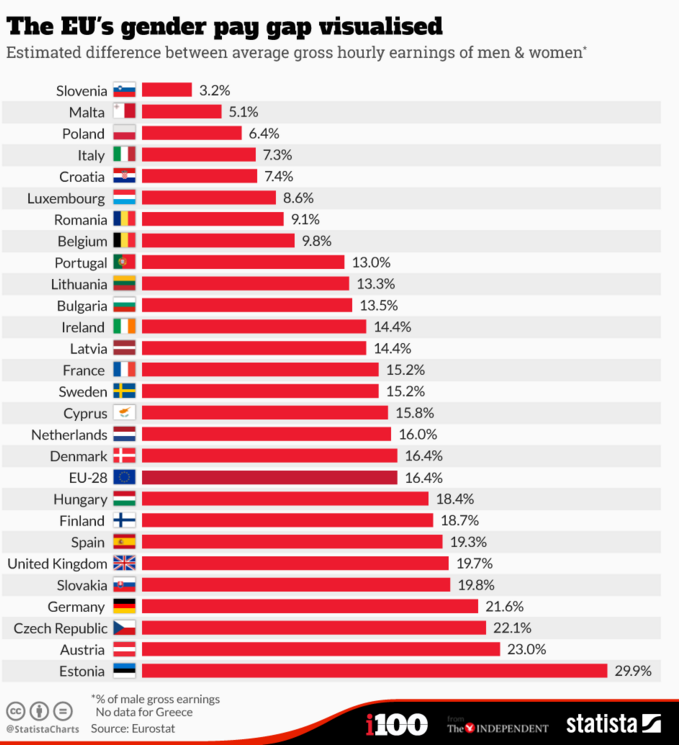Which European countries have the biggest gender pay gaps?
Stay up to date:
Future of Work
In Estonia, women earn almost 30% less than men, making it the largest gender pay gap in the European Union.
Although no member country has managed to completely close the gender pay gap, in the EU the situation is generally better than in other parts of the world.
These Eurostat statistics show the percentage difference between the average gross hourly earnings of men and women for each EU country. (Greece is not included due to a lack of data.)
Estonia has the biggest difference in the average gross hourly earnings of men and women, with men earning 29.9% more than women. This is followed by Austria, which has a 23% difference in wages.
That Germany appears among the top five countries with the largest gender pay gaps may come as a surprise. Despite its progressive equality policies, such as split parental leave, the country has a gap of 21.6%. Sweden and Finland have similarly progressive policies but also fall within the less equal half of the graph.
Slovenia, with 3.2%, is the most equal EU country. It is followed by Malta with 5.1% and Poland with 6.4%.
Globally, women continue to earn less than men, with the World Economic Forum’s Global Gender Gap Report 2015 showing that despite an increase in women’s earnings, their current worldwide average only equals what men were earning 10 years ago.
The imbalance of the gender wage gap has a direct impact on global economics. As talented females struggle to thrive in the workforce, it affects a country’s ability to generate sustainable growth and create jobs.
Have you read?
The 10 most gender equal countries in the world
5 things you didn’t know about the gender pay gap
15 women changing the world in 2015
To keep up with the Agenda subscribe to our weekly newsletter.
Author: Emma Luxton is a Digital Content Producer at Formative Content.
Image: A businesswoman walks on the esplanade of La Defense, in the financial and business district in La Defense, west of Paris. REUTERS/Gonzalo Fuentes.
Don't miss any update on this topic
Create a free account and access your personalized content collection with our latest publications and analyses.
License and Republishing
World Economic Forum articles may be republished in accordance with the Creative Commons Attribution-NonCommercial-NoDerivatives 4.0 International Public License, and in accordance with our Terms of Use.
The views expressed in this article are those of the author alone and not the World Economic Forum.
Forum Stories newsletter
Bringing you weekly curated insights and analysis on the global issues that matter.
More on Equity, Diversity and InclusionSee all
Ira Martopullo and Paulo Neves
May 30, 2025
Thelma Obiakor and Bisong Anthony Ekpang
May 23, 2025
Victor Dzau and Paula Bellostas Muguerza
May 21, 2025
Silja Baller
May 15, 2025
Tea Trumbic and Dhivya O’Connor
May 13, 2025
Harrison Lung and Hatem Bamatraf
May 7, 2025





